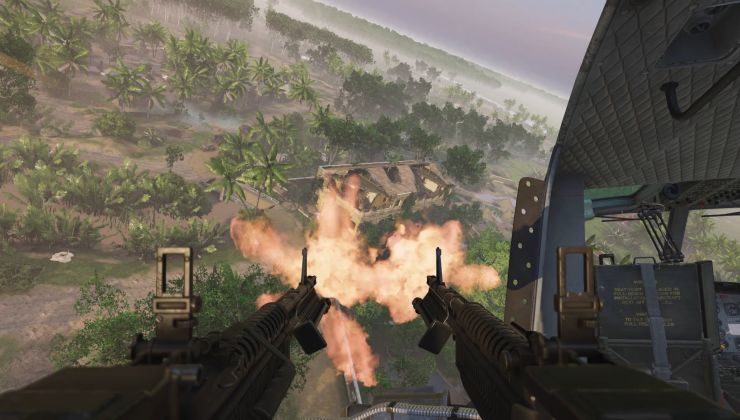Even though I am an Nvidia user, I am really impressed by what has been leaked out about AMD's upcoming Polaris.
I've always said if AMD come out with cards that perform well on Linux I would happily switch and it's looking like Polaris is moving me towards that some more.
WCCFtech have an article about leaked AMD Polaris 10 & 11 information and it really does make AMD's next generation GPU architecture sound awesome.
Although their naming is confusing. Polaris 11 is their lower end and Polaris 10 is their higher end. This is due to Polaris 10 being designed first.
Polaris 10 sounds pretty powerful:
The most impressive thing I've read about Polaris is not just the performance (which sounds great), but the drastically reduced power draw:
According to the article we will see more information on Polaris at the end of this month. Exciting times to be a gamer that's for sure, as graphics cards are becoming so powerful it's crazy.
Obviously it's still all speculative since these leaks may not be entirely true, and in Polaris 10's case it was based on a mobile GPU (which is still massively impressive!).
I am looking forward to seeing real-world tests of Polaris, especially on Linux (I imagine we can count on Phoronix for that). As an Nvidia 980ti user I won't be upgrading for quite a long time, but it's certainly putting AMD firmly on my radar as my next GPU choice if the Linux support is good.
I've always said if AMD come out with cards that perform well on Linux I would happily switch and it's looking like Polaris is moving me towards that some more.
WCCFtech have an article about leaked AMD Polaris 10 & 11 information and it really does make AMD's next generation GPU architecture sound awesome.
Although their naming is confusing. Polaris 11 is their lower end and Polaris 10 is their higher end. This is due to Polaris 10 being designed first.
Polaris 10 sounds pretty powerful:
QuoteAccording to today’s leak the GPU is rated at 5.5 TFLOPS, which is 0.1 TFLOPS shy of the 2816 SP R9 290X. An impressive feat considering the 290X is a ~290W card with 37.5% more GCN stream processors and a memory interface that’s twice as wide. The card is also reportedly rated at less than 150W. According to a previous leak from Benchlife Polaris 10 graphics cards will be rated at around 110W-135W depending on the GPU configuration and clock speeds. Interestingly, according to VCZ this 5.5 TFLOP GPU is not even a desktop class chip but a mobility variant. This would bring R9 390X/390 class performance to notebooks.
The most impressive thing I've read about Polaris is not just the performance (which sounds great), but the drastically reduced power draw:
QuotePolaris 11 on the other hand will feature 14 GCN 4.0 compute units for a total of 896 stream processors. The GPU features a 128bit GDDR5/X memory interface and Polaris 11 cards will feature 4GB of memory. The GPU is rated at 2.5 TFLOPS and a TDP that’s less than 50 watts.
That’s 0.5 TFLOPS north of the 110W R7 370 at less than half the wattage & exactly the same performance of the 180W R9 270X.
According to the article we will see more information on Polaris at the end of this month. Exciting times to be a gamer that's for sure, as graphics cards are becoming so powerful it's crazy.
Obviously it's still all speculative since these leaks may not be entirely true, and in Polaris 10's case it was based on a mobile GPU (which is still massively impressive!).
I am looking forward to seeing real-world tests of Polaris, especially on Linux (I imagine we can count on Phoronix for that). As an Nvidia 980ti user I won't be upgrading for quite a long time, but it's certainly putting AMD firmly on my radar as my next GPU choice if the Linux support is good.
Some you may have missed, popular articles from the last month:
All posts need to follow our rules. For users logged in: please hit the Report Flag icon on any post that breaks the rules or contains illegal / harmful content. Guest readers can email us for any issues.
... if the linux support is good....
i left amd cpu and gpu behind me years ago and my life only got better, that said is not healthy for the market with one brand monoplizing the shit out of said market. so i aplaud their efforts
i left amd cpu and gpu behind me years ago and my life only got better, that said is not healthy for the market with one brand monoplizing the shit out of said market. so i aplaud their efforts
4 Likes, Who?
... if the linux support is good....This is why I am hoping Polaris and Zen are both as good as they currently sound, but only time will tell.
i left amd cpu and gpu behind me years ago and my life only got better, that said is not healthy for the market with one brand monoplizing the shit out of said market. so i aplaud their efforts
2 Likes, Who?
As long as it keeps Nvidia in check and AMD some fighting space, we are good.
0 Likes
great news but im not really into the hype .. i want to see some real benchmarks and their linux driver support is still lacking and vulkan is still quite young.
amd zen however seems interesting..but again.. i wont buy into hype.. if the 40+% better IPC versus bulldozer is true and i can get my hands on 8c/16t with a reasonable ~300€ pricetag. then im all for it
amd zen however seems interesting..but again.. i wont buy into hype.. if the 40+% better IPC versus bulldozer is true and i can get my hands on 8c/16t with a reasonable ~300€ pricetag. then im all for it
4 Likes, Who?
I switched from NVIDIA a long time ago. If performance isn't your primary criteria (it happens, I'm the proof of it ;)), I strongly encourage to buy AMD. Just for the pleasure of seeing your machine booting up with a pretty good GPU acceleration without having anything to install, or even configure. But maybe it's something that only rings bells to the old Linux veterans like me ;)
As for Intel, I switched to AMD a year ago and I'm fairly happy with it. But here, the main reason was simply the price. Intel's good CPUs are ludicrously expensive, so I looked at AMD's offer and there I find that the quality/price ratio is better.
I'm actually looking for a new AMD GPU that might fit in my case. Since Polaris GPUs seem to dissipate less heat, will the card be a bit smaller too?
As for Intel, I switched to AMD a year ago and I'm fairly happy with it. But here, the main reason was simply the price. Intel's good CPUs are ludicrously expensive, so I looked at AMD's offer and there I find that the quality/price ratio is better.
I'm actually looking for a new AMD GPU that might fit in my case. Since Polaris GPUs seem to dissipate less heat, will the card be a bit smaller too?
3 Likes, Who?
Yes good news for laptops and low power usage consumers. However 5.5TFOPS is almost half of what the 1080 card will offer, so be aware of that. (performance per watt, I think NVIDIA win in that respect, but at 180TDP)
Also even tho the Linux drivers are getting better under Linux, they still have a long way to go. I use WARTHUNDER for my testing, when that game is playable at 50-60fps at 4k with AMD hardware, I will be excited. (ATM it can only achieve that with everything turned off, it looks like Mario 64)
Last edited by TheRiddick on 16 May 2016 at 9:48 pm UTC
Also even tho the Linux drivers are getting better under Linux, they still have a long way to go. I use WARTHUNDER for my testing, when that game is playable at 50-60fps at 4k with AMD hardware, I will be excited. (ATM it can only achieve that with everything turned off, it looks like Mario 64)
Last edited by TheRiddick on 16 May 2016 at 9:48 pm UTC
2 Likes, Who?
TeamEVGA...haha sorry red boys!
goVEGAN
goVEGAN
0 Likes
I'll probably buy a Polaris card to get rid of Nvidia blob, since Nvidia still didn't open source their driver / didn't back Nouveau properly. With upcoming Vulkan driver from AMD being open source, it's good time to get an AMD card, especially if as some say Polaris 10 will be comparable or even better than GTX 980.
Last edited by Shmerl on 16 May 2016 at 11:53 pm UTC
Last edited by Shmerl on 16 May 2016 at 11:53 pm UTC
3 Likes, Who?
Yes good news for laptops and low power usage consumers. However 5.5TFOPS is almost half of what the 1080 card will offer, so be aware of that. (performance per watt, I think NVIDIA win in that respect, but at 180TDP)Keep in mind that, if the article is correct, this is a mobility-class GPU, not a desktop one. That sounds impressive to me.
0 Likes
Better prepare my wallet I may need between 2 and 4 Polaris cards for gaming rigs.
As always with AMD, show me the stats, no trigger pulling until it's good enough the driver n gpu
As always with AMD, show me the stats, no trigger pulling until it's good enough the driver n gpu
0 Likes
... if the linux support is good....
i left amd cpu and gpu behind me years ago and my life only got better, that said is not healthy for the market with one brand monoplizing the shit out of said market. so i aplaud their efforts
Yeah, absolutely this. Monopolies are bad. But Linux users already know that! :D
1 Likes, Who?
Yeah, absolutely this. Monopolies are bad. But Linux users already know that! :D
Even if we have a healthy marketplace with competition between AMD/Nvidia or between Intel/AMD for CPU it's still only two. A duopoly! And don't point to VIA or Matrox, there are only two companies competing in either CPU and GPU which produce respectable, high performance parts worthy of desktop + gaming. Patents and licensing deals have removed freedom and choice from the x86 ecosystem and we're all worse off because of it.
2 Likes, Who?
I think the Zen processors will be a good move for AMD and should give them a boost... However I won't touch their graphics cards (though I used to prefer AMD GPUs) until I see a solid performing driver from them. They can have a really amazing GPU but if they have crappy drivers (which they still do) then it really doesn't matter how good the card is.
1 Likes, Who?
Even if we have a healthy marketplace with competition between AMD/Nvidia or between Intel/AMD for CPU it's still only two. A duopoly! And don't point to VIA or Matrox, there are only two companies competing in either CPU and GPU which produce respectable, high performance parts worthy of desktop + gaming. Patents and licensing deals have removed freedom and choice from the x86 ecosystem and we're all worse off because of it.
We'll agree that it is impossible to arrive as a credible competitor, out of the blue. Also, high performance CPU and GPU aren't as profitable markets than in the past decade. So, in that regards, I think ARM is a serious competitor since it owns everything but the desktop.
And I actually won't be surprised to see high end desktop ARM CPU in the years to come.
And to go a little further, I'm not sure graphics cards is a safe horse on which to bet today. I think graphics cards will follow the same fate as the sound cards and the APU will be the norm. I'm fairly sure both AMD and NVIDIA know that very well.
So I do think there is an interesting competition out there. It's just that it's not the one we're expecting. We would like to see a giant competitor arriving and splitting the market, but that rarely happens and even less on a market that is decreasing.
Last edited by Creak on 17 May 2016 at 4:56 am UTC
1 Likes, Who?
I've had my fair share of issues with my nvidia rig in the past years. Nouveau - with all the effort - is giving me hard times (crashes, random lock-ups, graphics issues - even on most recent kernels with a GTX770). NVidia has their own issues, with optimus hardware, with the wayland implementation working differently than everywhere else etc.
Since in December I'm getting myself a new gaming rig, I'll consider buying AMD this time. Though, I'm pretty sure my CPU will be intel again, but we'll see what AMD has in the stocks then.
Last edited by STiAT on 17 May 2016 at 5:23 am UTC
Since in December I'm getting myself a new gaming rig, I'll consider buying AMD this time. Though, I'm pretty sure my CPU will be intel again, but we'll see what AMD has in the stocks then.
Last edited by STiAT on 17 May 2016 at 5:23 am UTC
0 Likes
It is good to see, that AMD is putting in more and more effort, on CPU and GPU side. Intel and NVidia need some more competition, so all stay more innovative and reasonable about pricing. We as users (regardless of what we buy) can only benefit from that.
I upgraded my rig one and a half year ago, so no upgrade in the near future. But maybe in a year or so I want to upgrade my GPU. If Polaris is ready on time and has good FOSS Drivers, I will seriously consider them.
I upgraded my rig one and a half year ago, so no upgrade in the near future. But maybe in a year or so I want to upgrade my GPU. If Polaris is ready on time and has good FOSS Drivers, I will seriously consider them.
1 Likes, Who?
Polaris is not just important in order to make the market more competitive, but also for the openness and even usability of our platform. AMD doing really great work on open source drivers lately, making systems with fully open source drivers viable, and even if you decide to use GPUPRO, only a small part of your driver will be closed source. This has benefits for freedom, but the fact that your GPU will work optimally right after you install your Linux distribution has great benefits to make Linux more accessible and easier for people.
I'm already a Radeon user and did never regret my puchase. Upgrading to Polaris will be a very easy decision.
I'm already a Radeon user and did never regret my puchase. Upgrading to Polaris will be a very easy decision.
2 Likes, Who?
I would really like to give my money to AMD this time around, especially since I'm still having this bitter taste in my mouth and feeling slightly cheated after the 3.5+0.5 GB video memory situation (not to say that 970 is a bad card though). I'll wait and see if AMD can get their drivers and performance competitive - if not then I'm staying in the green camp.
When it comes to CPUs Intel looks less and less appealing to me - the cheapest 8/16 will be 999 dollars, that's too much for me personally. If AMD offers a competitive octacore at a reasonable price then I'm sold.
http://www.computerbase.de/2016-05/broadwell-e-intel-core-i7-6950x-1.569-us-dollar/
When it comes to CPUs Intel looks less and less appealing to me - the cheapest 8/16 will be 999 dollars, that's too much for me personally. If AMD offers a competitive octacore at a reasonable price then I'm sold.
http://www.computerbase.de/2016-05/broadwell-e-intel-core-i7-6950x-1.569-us-dollar/
1 Likes, Who?
I've been thinking that I'll be using a Polaris GPU as my passthrough for a Windows gaming VM. Okay driver support in Windows, and support the other (graphics) team? Sure, why not.
0 Likes
#ShowMeTheDrivers
4 Likes, Who?















 How to set, change and reset your SteamOS / Steam Deck desktop sudo password
How to set, change and reset your SteamOS / Steam Deck desktop sudo password How to set up Decky Loader on Steam Deck / SteamOS for easy plugins
How to set up Decky Loader on Steam Deck / SteamOS for easy plugins
See more from me